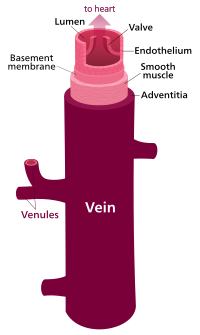
Photo from wikipedia
Dear Editor, With great interest, we read the article by Yuan et al.1 about a case of a fetus with an ectopic connection of the ductus venosus (DV) to a… Click to show full abstract
Dear Editor, With great interest, we read the article by Yuan et al.1 about a case of a fetus with an ectopic connection of the ductus venosus (DV) to a dilated coronary sinus (CS) which was initially detected with prenatal echocardiography. The postnatal outcome of this fetus was good. This article broadens my mind and explains in some degree why some neonates have normalsize cardiac chambers with an inexplainable dilated CS without any other cardiac anomalies. After deeper study, we found this kind of CS dilation may be the consequence of the fetal venous anomalies, which can be divided into three types: (1) left umbilical vein (LUV) connection with CS associated with agenesis of the DV (ADV); (2) LUV connection with CS via DV; (3) persistent right umbilical vein (PRUV) connection with CS associated with ADV. In type one, ADV leads to shunting of UV blood through an aberrant vessel that may flow either into extrahepatic veins such as the iliac vein, inferior vena cava, superior vena cava, right atrium or CS, or via an intrahepatic venous network, through the portal sinus to the hepatic sinusoid. There were five articles and seven fetuses with this type.2–6 Most fetuses (5/7) had good outcome. Then, LUV connects with CS via a normal DV in type two. There were two articles and five fetuses with this type.1,7 Previous study proposed an explanation for this embryonic development abnormality: DV connected with the proximal part of the left hepatocardiac channel (left vitelline vein), rather than in the right as usual.7 All fetuses have good outcome in type two. In type three, PRUV has a prevalence of 0.2%0.4% in fetuses8 and causes by the failure of right UV regress. PRUV may replace the left UV or be found as an intrahepatic supernumerary vein, connecting to the right portal vein. It may also bypass the liver, causing aberrant drainage of blood into the inferior vena cava, right atrium, or CS. There was only one case in the literature, which described a fetus with ADV had the UV bifurcated within the liver, associated with PRUV draining directly to the CS.9 The neonate was born at 35+5 weeks without any symptom. Above three types of fetal venous anomalies usually have no or mild consequence. At birth, the umbilical cord section induces the UV closed. The only imaging abnormality that persists on postnatal echocardiography may be the dilated CS, even 47 days after birth.1 Although, the moment that caliber of CS back to normal is still unknown. In brief, when neonatal echocardiography was performed, finding an “inexplainable” dilated CS would be easier to be understood by the doctors if they had the whole fetal ultrasonographic results about venous anomalies.
Journal Title: Echocardiography
Year Published: 2017
Link to full text (if available)
Share on Social Media: Sign Up to like & get
recommendations!